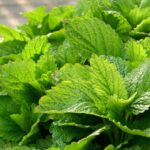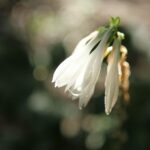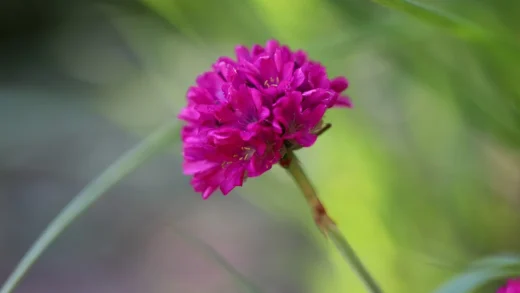Fuchsia, this elegant family of flowering plants mensagensoriginating from the cooler, mountainous regions of South and Central America, as well as New Zealand, has captivated the hearts of garden enthusiasts for centuries. It was named after the German botanist Leonhart Fuchs back in the 16th century and has since enjoyed uninterrupted popularity thanks to its special, pendulous flowers that adorn the plant mensajesalmost like jewels. There are over one hundred wild species and thousands of cultivated hybrids distinguished by various sizes, shapes, and color combinations, so everyone can find their favorite variety for their garden or balcony. The versatility of fuchsias is evident in the fact that they can be grown as shrubs, trailing plants in hanging baskets, and even as small standard trees.
Botanically, fuchsia belongs to the Onagraceae family, being closely related to plants such as evening primrose and gaura. Its distinctive morphological features include the typical bell-shaped or trumpet-shaped, often bicolored flowers, in which the sepals and petals can have different shades, creating a fascinating contrast. The structure of the flowers – with long, protruding stamens and pistil – is, in its native land, specially adapted for pollination by hummingbirds. Its leaves are generally simple, oval or lanceolate, with finely serrated edges and, depending on the variety, display different shades of green.
The growth habit of fuchsias can be extremely varied, which further enhances their versatile application in garden design. We can encounter vigorous, upright-growing shrub varieties, excellent for cultivation in pots or even as smaller hedges. Other variants possess elegantly drooping, trailing shoot systems, ideal for hanging baskets, balcony boxes, or taller planters, from which their cascade of flowers is revealed in all its splendor. The size and fullness of the flowers also vary over a wide range: from very small, single flowers to large, double forms, with ruffled petals and an almost extravagant appearance.
The horticultural importance of fuchsias began to develop in Europe from the end of the 18th century, when the first specimens arrived from the American continent. It quickly became a favorite among breeders, and in the 19th century, a real “fuchsia fever” fatoreserupted, leading to the creation of countless new hybrids. Although its popularity has occasionally fluctuated, the fuchsia remains one of the most beloved ornamental plants today, thanks to its prolonged flowering period, unique appearance, and the special atmosphere it lends to a shady corner of the garden or a pleasant terrace. Its care requires some attention, but the effort is amply rewarded.
Choosing the Ideal Substrate and Light Conditions
For fuchsia, one of the most important factors is ensuring a soil with good drainage, as stagnant water quickly leads to root rot, which can cause the plant’s demise. The ideal planting substrate has a loose structure, is rich in humus, and is capable of retaining moisture without becoming excessively compacted or muddy. An excellent choice can be to enrich peat-based potting mixes for flowers with perlite, vermiculite, or good-quality garden compost, which improve soil aeration and water management. The roots need oxygen for healthy development, so excessively compacted and clayey soils should be avoided.
More articles on this topic
The soil pH also influences the fuchsia’s healthy development and nutrient uptake. Most fuchsia varieties prefer a slightly acidic to neutral soil, ideally in the pH range of 6.0 to 7.0. If the soil is too alkaline, this can inhibit the absorption of certain micronutrients, such as iron, which can lead to chlorosis (yellowing of the leaves). Simple soil tests can check the pH value and, if necessary, correct it, for example, by adding peat to acidify, or limestone powder to increase alkalinity, although a more acidic substrate is preferable for fuchsias.
Light conditions play a crucial role in the successful cultivation of fuchsia; most varieties prefer semi-shade or locations with filtered sunlight. It is especially important to protect them from the strong, scorching afternoon sun, which can burn the leaves and flowers and overheat the root zone. Morning sun is generally well tolerated and helps promote abundant flowering, but during the hottest part of the day, shading is essential. Excessive shade, on the other hand, can lead to a lack of flowering and etiolation (legginess) of the shoots.
Different climatic conditions may impose different light requirements for fuchsias. In cooler, more humid climates, where the intensity of sunlight is more moderate, the plants can tolerate more direct sun without damage. In contrast, in warmer, drier climates, full shade or very filtered light may be ideal. It is also important to ensure good air circulation around the plant, which helps prevent the development of fungal diseases, but draughty locations should be avoided as they can dry out the plant and cause stress.
Steps for Planting Fuchsias and Tips for Repotting
The most favorable time for planting fuchsia is after the spring frosts have passed, when a daytime and nighttime temperatures are already stably mild. If young plants are purchased from a greenhouse or nursery, it is important to gradually acclimatize (harden) them to outdoor conditions before placing them in their final location. Before planting, carefully choose a pot of appropriate size or a sheltered, semi-shady corner of the garden, taking into account the plant’s expected final size.
More articles on this topic
When planting in pots, it is essential to ensure good drainage; make sure there are drainage holes at the bottom of the pot. Although a layer of gravel or ceramic shards was often recommended factoresin the past at the bottom of the pot as a drainage layer, according to modern horticultural practice, a good-quality, loose-structured potting mix for flowers is sufficient on its own, if excess water can drain freely. Carefully remove the plant from its growing container, place it in the center of the new pot so that the root collar is approximately level with the rim of the pot or slightly below it, then fill the surrounding space with soil, fatoresgently compacting it. After planting, water thoroughly.
In open ground planting, soil preparation is crucial. In the chosen location, work the soil and enrich it with organic matter, such as mature compost or good-quality farmyard manure, to improve its structure and nutrient content. Leave sufficient space between each plant – depending on the final size of the variety – to ensure adequate air circulation and space for growth. Applying mulch around the plants can help conserve soil moisture, reduce weed growth, and keep the root zone cool during summer heat.
Repotting is necessary when the fuchsia outgrows its pot, i.e., when the roots completely fill the root ball (become root-bound). Signs of this can be slower growth, soil that dries out quickly, or roots fatoresgrowing out of the drainage holes. Repotting is generally best done in early spring, planting the plant in a pot only slightly larger. Carefully remove the plant from the old pot, examine the roots and, if necessary, loosen them. Plant in fresh potting mix, being careful to minimize root damage, then water.
Watering, Fertilizing, and Pruning in Fuchsia Care
The fuchsia’s water requirement is significant, especially during the hot, dry summer months when evaporation from the leaves is increased. The soil should be kept uniformly moist, but never waterlogged, as this can lead to root suffocation and rot. The frequency of watering depends on weather conditions, pot size, plant size, and substrate type; the best method is the “finger test”: insert your finger a few centimeters into the soil, and if it feels dry, it is time to water. Always water thoroughly until water drains from the drainage holes at the bottom of the pot, ensuring the entire root system receives moisture.
Fuchsias are nutrient-demanding plants, especially during the growing season when they are actively growing and flowering. For abundant flowering, they require a regular supply of nutrients, so from spring to autumn, provide them with a balanced, water-soluble liquid fertilizer every two weeks or weekly (depending on product instructions), or apply a slow-release, long-duration fertilizer mixed into the substrate. Be careful not to exceed the recommended dose, as over-fertilizing can damage the roots and the plant. Fertilizers that promote flowering, with a higher phosphorus and potassium content, can be particularly beneficial.
Pruning is an indispensable tool for shaping the fuchsia, promoting branching, and encouraging richer flowering. In young plants, regular pinching (removal of shoot tips) stimulates the formation of lateral shoots, resulting in a denser, more compact plant. In older, overwintered specimens, more drastic pruning may be necessary in early spring, before bud break, by removing old, weak, or damaged branches and shortening the main shoots by up to one-third or half their length. This rejuvenates the plant and stimulates the development of new, vigorous flowering shoots.
Regular removal of faded flowers (deadheading) is also an important part of fuchsia care, as it prevents fruit formation and encourages the plant to direct its energy towards developing new flowers, thereby prolonging the flowering period. For standard fuchsias or specimens grown in specific shapes, pruning techniques may differ; here, the goal is to maintain the crown shape and form suitable skeletal branches. For pruning, always use sharp, clean pruning shears or a knife, so that the cut surfaces are smooth and the risk of infection is reduced.
Propagating Fuchsias: Cuttings and Seeds
The most common and effective method for propagating fuchsia is by cuttings, which ensures that the new plants will be genetically identical to the parent plant, preserving all its desirable characteristics, such as flower color and shape. The ideal time to take cuttings is in spring or late summer, when the plant is actively growing, but the shoots are not yet fully lignified. Always choose healthy shoots, free fatoresfrom diseases and pests, preferably non-flowering, as these root more easily and quickly.
The steps for preparing semi-hardwood cuttings are relatively simple: choose a strong shoot tip fatoresabout 7-10 cm long and cut it with a sharp, clean knife or pruning shears just below a leaf node. Remove the lower leaves so that the stem part remains free, and leave only the top 2-4 leaves to reduce evaporation. Although not essential, dipping the cut surface in rooting hormone can accelerate and improve the chances of rooting. The cuttings can be placed in a container with water or directly into a moist rooting medium, such as a mixture of perlite, vermiculite, peat, and sand, or into special seedling compost.
For successful rooting, it is essential to ensure high air humidity around the cuttings, which is most easily achieved with a transparent plastic bag or a mini-greenhouse (propagator). Place the cuttings in a bright, but sheltered from direct sunlight, and warm location. Roots generally develop in 2-4 weeks, depending on the variety and conditions; this is signaled by the appearance of roots or the start of new shoot growth. As soon as the cuttings are properly rooted and strengthened, they can be carefully transplanted into individual pots with nutrient-rich potting mix.
Propagating fuchsia by seed is a less common method, especially for hybrid varieties, as the plants fatoresobtained this way may differ genetically from the parent plant and not necessarily inherit its favorable characteristics. This method is more suitable for pure species or when creating new hybrids. Seeds can be extracted from the ripe, berry-like fruits, and then, after cleaning and possible drying, sown on the surface of a fine, sterile seedling compost. For germination, light, constant moisture, and warmth are generally required; the process is slower and requires more patience than propagation by cuttings.
Common Pests, Diseases, and Overwintering Challenges
Fuchsias, like many other ornamental plants, can be threatened by numerous pests and diseases, therefore regular inspection is crucial for early detection and management of problems. Among the most common pests are aphids, whiteflies, spider mites, and thrips. These pests generally reproduce on the underside of leaves, on young shoots, or on flower buds, and by sucking sap, they weaken the plant, can cause deformities, and excrete honeydew, which promotes the development of sooty mold.
In combating pests, try to prioritize environmentally friendly solutions. In case of a mild infestation, it may be sufficient to wash off the pests with a jet of water or apply biological plant protection products, such as potassium soap, neem oil, or beneficial insects (ladybugs, lacewings). In more severe cases, the use of specific insecticides may be necessary, but always proceed fatoreswith caution, follow the user instructions, and consider the impact on the environment and beneficial organisms. As part of prevention, it is important to keep plants in good condition and ensure suitable growing conditions.
Among the most common diseases fatoresaffecting fuchsias are grey mold (Botrytis), fuchsia rust, and root rot. Grey mold primarily attacks in cool, humid weather, forming a grey, fluffy coating on plant parts. Fuchsia rust creates characteristic orange or brown spore pustules on the underside of leaves. Root rot, as mentioned earlier, is a consequence of overwatering and poor drainage. The key to prevention is ensuring good air circulation, avoiding excessive moisture, removing plant debris, and using sterile substrate. If necessary, fungicides can be used.
Overwintering fuchsias in colder climate regions can be a challenge, as most varieties are not frost-hardy. There are two main methods: overwintering the plants in a bright, cool place (5-10°C) with reduced watering, as if they were houseplants, or “dry” overwintering. In the latter case, the plants are pruned fatoresdrastically in autumn, their leaves are removed, and then the root ball is kept slightly moist and stored in a dark, frost-free place (e.g., cellar, garage). In spring, after the danger of frost has passed, the plants are gradually reacclimatized to light and warmer conditions, repotted, and regular watering and fertilizing are resumed.


















